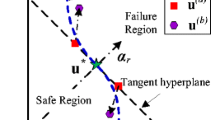Abstract
The explicit expressions of performance or limit state functions are not available for most of realistic structural problems, particularly when nonlinear behavior needs to be incorporated in the formulation. Thus, the limit state functions may only be available in implicit or algorithmic forms such as finite element formulations. An efficient and accurate algorithm to estimate reliability of such structural systems is proposed in this paper. All the load and resistance-related parameters are modeled as realistically as possible and the uncertainty in them is also explicitly addressed. the proposed algorithm intelligently integrates the concepts of the response surface method, the finite element method, the first order reliability method, and the iterative linear interpolation scheme. To assure both computational efficiency and accuracy of the algorithm, two iterative response surface schemes are proposed using two-second order polynomials (with and without the cross terms) and a mixture of saturated and central composite designs. The algorithm is further elaborated with the help of two examples and is verified using the Monte Carlo simulation technique.
Similar content being viewed by others
References
Box, G. P., William G. H. and Hunter, J. S. (1978).Statistics for Experimenters: An Introduction to Design, Data Analysis and Modeling Building. John Wiley & Sons, New York, N.Y.
Box, M. J. and Wilson, K. B. (1951). “On the Experimental Attainment of Optimum Conditions (with discussion).”J. Roy. Statist. Soc., Vol. B 13, pp. 1–45.
Bucher, C. G. and Bourgund, U. (1990). “A fast and efficient response surface approach for structural reliability problems.”Structural Safety, Vol. 7, pp. 57–66.
Faravelli, L. (1989). “Response-Surface Approach for Reliability Analysis.”ASCE Journal of Engineering Mechanics, Vol. 115, No. 12, pp. 2763–2781.
Haldar, A. and Mahadevan, S. (2000).Probability, Reliability and Statistical Methods in Engineering Design. John Wiley & Sons, New York, N.Y.
Huh, J. and Haldar, A. (1999). “Reliability Analysis Under Dynamic Loadings.”Proc. 8th International Conference on Applications of Statistics and Probability (ICASP8-99), pp. 789–796.
Khuri, A. I. and Cornell, J. A. (1996).Response Surfaces Designs and Analyses. Marcel Dekker, New York, N.Y.
Lucas, J. M. (1974). “Optimum Composite Designs.”Technometrics, Vol. 16, No. 4, pp. 561–567.
Kim, S. H. and Na, S. W. (1997). “Response surface method using vector projected sampling points.”Structural Safety, Vol. 19, No. 1, pp. 3–19.
Rajashekhar, M. R. and Ellingwood, B. R. (1993). “A new look at the response surface approach for reliability analysis.”Structural Safety, Vol. 12, pp. 205–220.
Author information
Authors and Affiliations
Additional information
The manuscript for this paper was submitted for review on May 18, 2000.
Rights and permissions
About this article
Cite this article
Huh, J. Reliability analysis of nonlinear structural systems using response surface method. KSCE J Civ Eng 4, 135–143 (2000). https://doi.org/10.1007/BF02830867
Issue Date:
DOI: https://doi.org/10.1007/BF02830867



